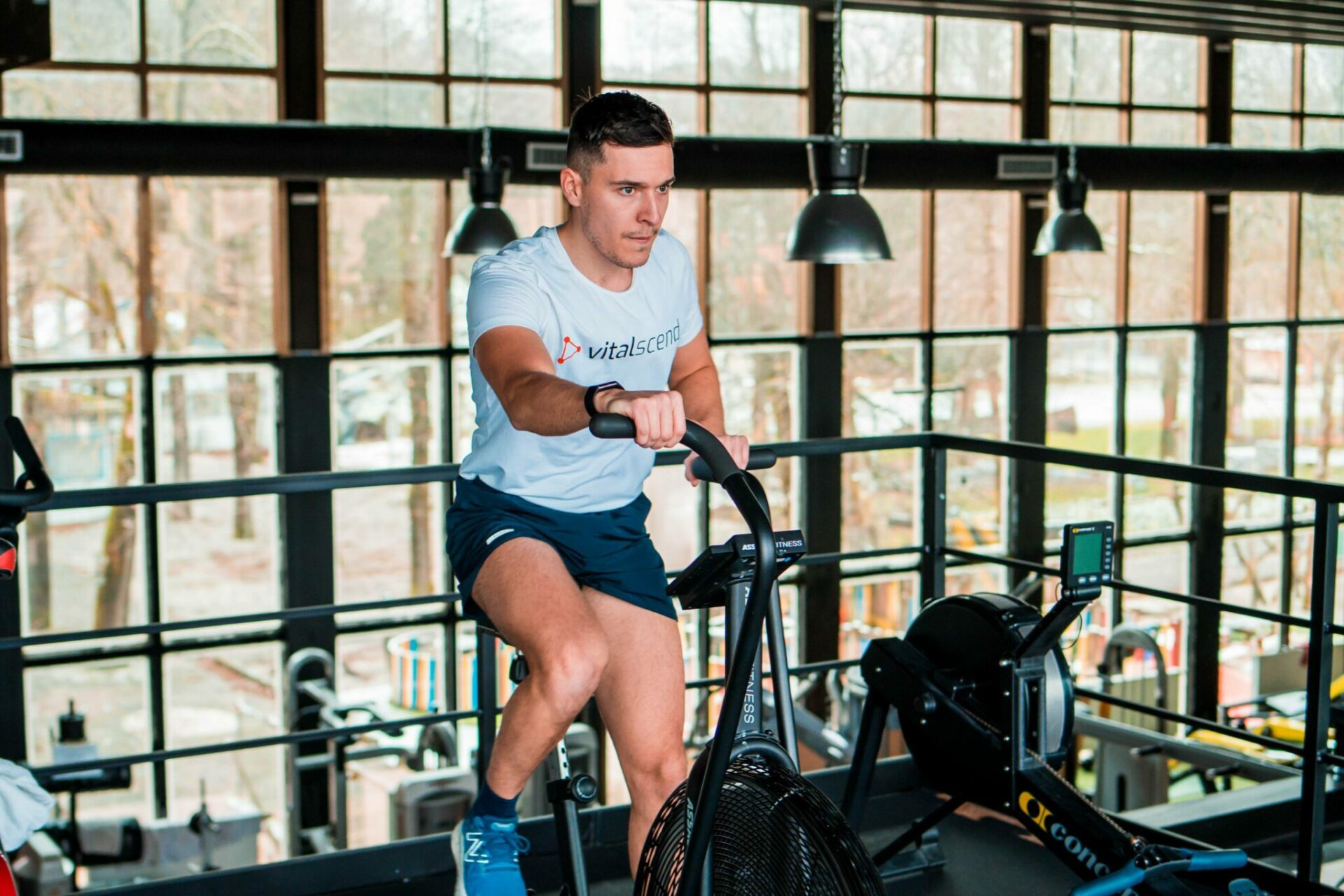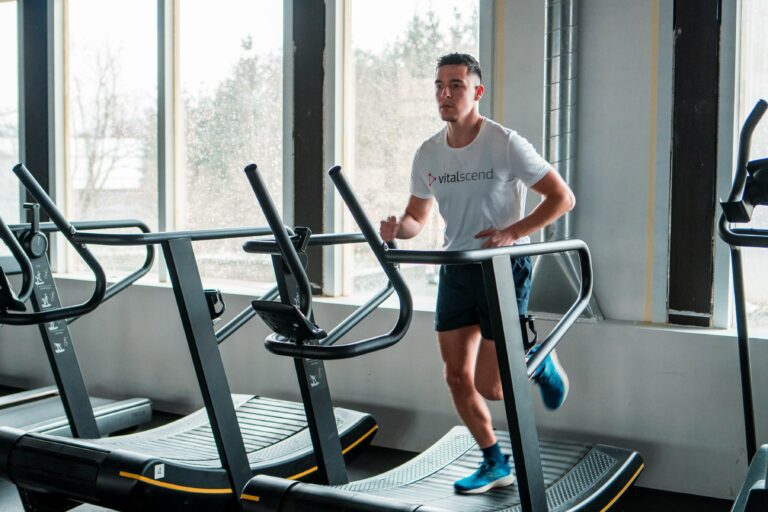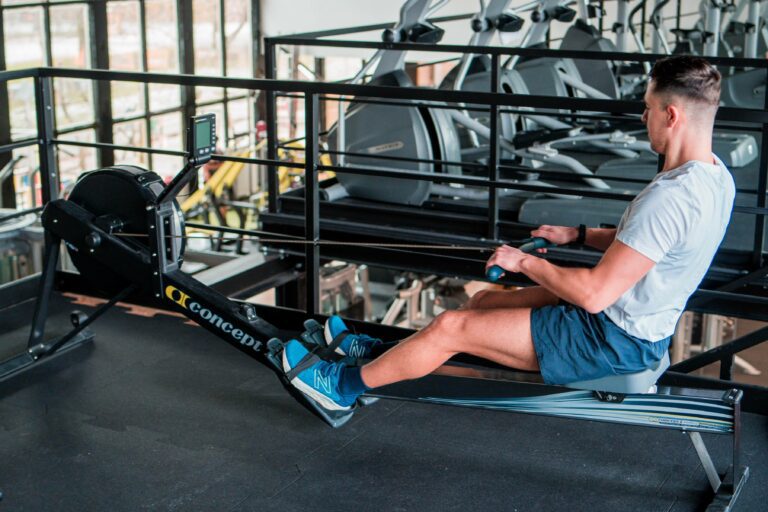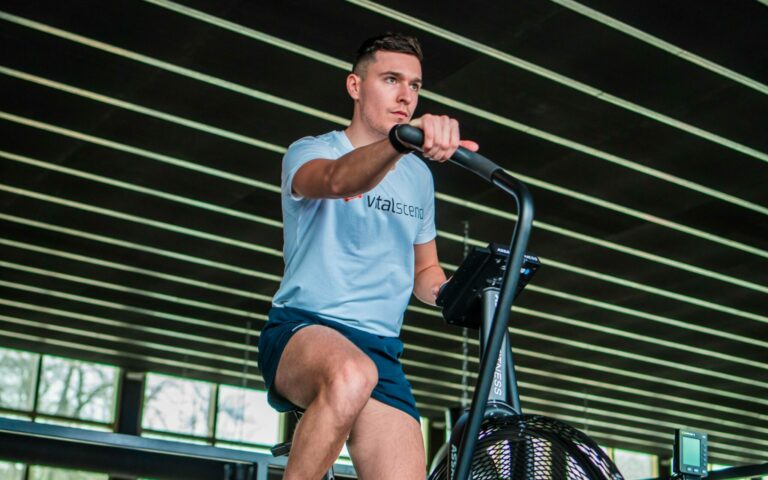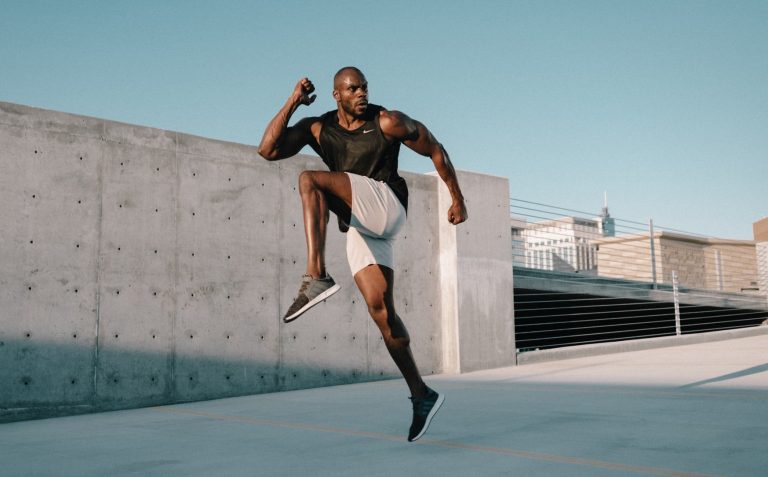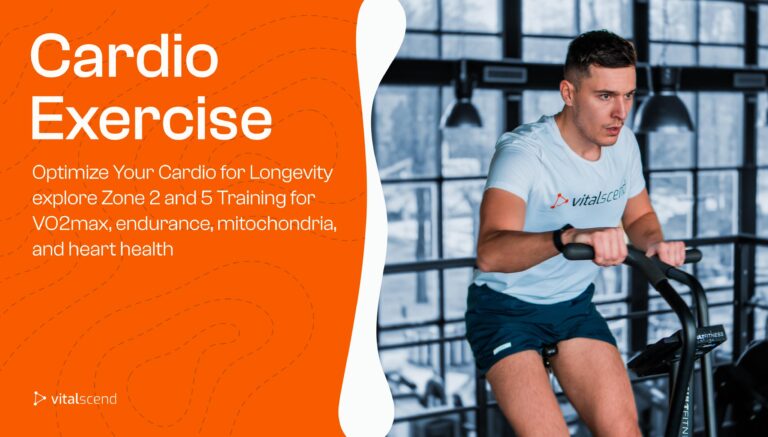VO2max and Cardiorespiratory Fitness as Longevity Predictors
VO2max is one of the key measures of cardiorespiratory fitness. It’s one of the key predictors of longevity, as it heavily correlates with a longer lifespan. It’s important to move, run, swim, and hike more, and we’ll see why.
Doing aerobic exercise is great for the heart. It improves cardiovascular health on so many levels. Cholesterol, vascularity, circulation… we can go on and on. But there’s one magic piece to the equation that extends our life, and that’s VO2max.
Cardiorespiratory Fitness
Cardiorespiratory fitness is the ability of your respiratory and circulatory system, aka the heart, vessels, and lungs to work together to bring fresh oxygen to the muscle. The better it is, the higher your endurance and aerobic power. (1)
Whether you call it aerobic or CRF fitness, it’s on you. It’s the functional capacity of your body to supply enough oxygenated blood. Why? So you can bring more water, nutrients, and O2 to create more energy and sustain exercise at a given intensity.
Those who excel at it, seem to be healthier, more vital, and live longer. It’s a simple equation, the more you move, the more your body adapts to it. Adaptations happen in the lungs and the heart, but also peripherally in the muscle.
Fun Fact
Cardiorespiratory fitness depends on multiple factors. Your maximal heart rate speed, stroke volume, hemoglobin efficiency, slow twitch fibers, and volume of oxygen you can uptake to the smallest tiny enzymes and mitochondria processes that create energy.
What is VO2max?
VO2 is the volume of oxygen uptake. Basically, how much oxygen you can breathe in. VO2max is the maximal oxygen uptake or maximal aerobic capacity, measured in ml/kg/min. Basically, how much oxygen can you uptake and effectively use during exercise.
It’s the key measure of cardiorespiratory fitness. It shows how good your body is at taking in, transferring, and using oxygen in the muscle.
VO2max = Cardiac Output x a-vO2 difference.
Don’t worry, it ain’t as hard as it looks.
- Cardiac output = stroke volume x heart rate
- Stroke volume is the volume of blood your left ventricle pumps out
- Heart rate is the number of beats per minute.
- a-vO2 diff – is how much oxygen your muscles took in
VO2max is measured in a laboratory setting for the most accuracy, but some smartwatches or formulas do a great job of predicting it. It’s done on a cycle ergometer or a running treadmill. You basically run (cycle) at a given intensity, which increases in increments with time, while wearing a mask that analyzes expired air (CO2). You reach a point at which even if you increase the speed, VO2 reaches a plateau. You can run faster using anaerobic fuel, but not more oxygen. That’s your VO2max point.
Fun Fact
VO2max of endurance athletes hovers over 65-80 ml/kg/min, with the elite ones having around 90 ml/kg/min. Healthy adults have around 30-35 for females, and 40-45 for males. In the elderly, VO2max values go even under 20 ml/kg/min.

Why VO2max and CRF are Important for Health
Higher VO2max and cardiorespiratory fitness mean you’re more aerobically capable. You can create more energy, use oxygen more efficiently, and move more. This corresponds to a ton of benefits for overall health and wellness.
Numerous studies show a strong link between higher VO2max or CRF values and longevity. (2) (3) (4)
Why is VO2max so important? Many diseases such as obesity, insulin resistance, and diabetes stem from poor glucose control. Activity plays a big factor in, as it helps expand more calories, improve insulin sensitivity, and create more energy – leading to weight loss. (5) (6) (7)
Poor aerobic or cardiorespiratory function develops from inactivity. As it accumulates, the results are higher blood pressure, inflammation, and dysfunctional mitochondria.
With aerobic exercise, we flip the switch. Resting heart rate and blood pressure go down. Cholesterol profile is improved, new blood vessels and mitochondria are generated. This means better circulation, more energy, and less inflammation. (8) (9) (10)
How can I increase my VO2 max?
Increasing VO2max levels is best done by incorporating high-intensity training that works your heart and lungs. Most effectively, these are short sprints with an active break like 15s:15s or longer intervals like 3-5 minutes done at VO2max velocity, with active rests for recovery.
Are cardio and aerobic exercise the same?
Running, cycling, and swimming are examples of aerobic exercise, which uses continuous, rhythmic movements of large muscle groups. Therefore, aerobic activity and cardio are essentially the same. However, other forms of exercise that raise your heart rate, such as HIIT or circuit training, can also be referred to as cardio.
How long should I do cardio exercise for optimal health benefits?
For optimal health benefits, it’s recommended that adults get at least 150 minutes of moderate-intensity cardio exercise per week. This can be broken down into 30 minutes of exercise, five days a week. For additional health benefits, it’s recommended to have either 150 minutes of high-intensity or 300 minutes of low-to-moderate-intensity activity.
VO2max Declines with Age
As we age, many systems in the body deteriorate. The functionality of our skeletal muscles, brain, the cardiovascular and respiratory system are in a steady decline. So is VO2max.
As aerobic fitness is dependent on your heart, lungs, and muscles – it drops when they do. Here’s what happens as we age:
- respiratory muscle strength is decreased, along with poor perfusion in the lungs
- stroke volume declines, as well as HRmax. Arteries stiffen, nitric oxide isn’t so bioavailable so circulation is diminished.
- mitochondrial dynamics and respiration in the muscles is weaker, reducing the arteio-venous oxygen difference
So, some reduction in VO2max is normal, but how much? See, VO2max decreases at a rate of 10% per decade, which is faster than it should be. It’s mostly limited by stroke volume, maximal voluntary ventilation, and diffusion capacity of the lungs, which are declining at 5-6%. (11)
What does this mean? That we should exercise more to keep our body at a higher aerobic capacity. Doing so reduces the drop in VO2max as we age, keeping us young and vital.
- Aerobic exercise can increase VO2max in the elderly by 6-30%, which can highly affect mortality risk. (12)
- Another study tested 4 months of aerobic conditioning in elderly people between 55 and 70 yrs. Walking fast or jogging at a targeted heart rate led to a whopping 27% increase in VO2max. (13)
Fun Fact
Aerobically trained people at 70 can have the same VO2max values as a non-active 50-year-old. Everyone, even endurance athletes experience VO2max declines with age. But those who do aerobic training seem to be relatively higher on the VO2max scale and keep a steadier decline.
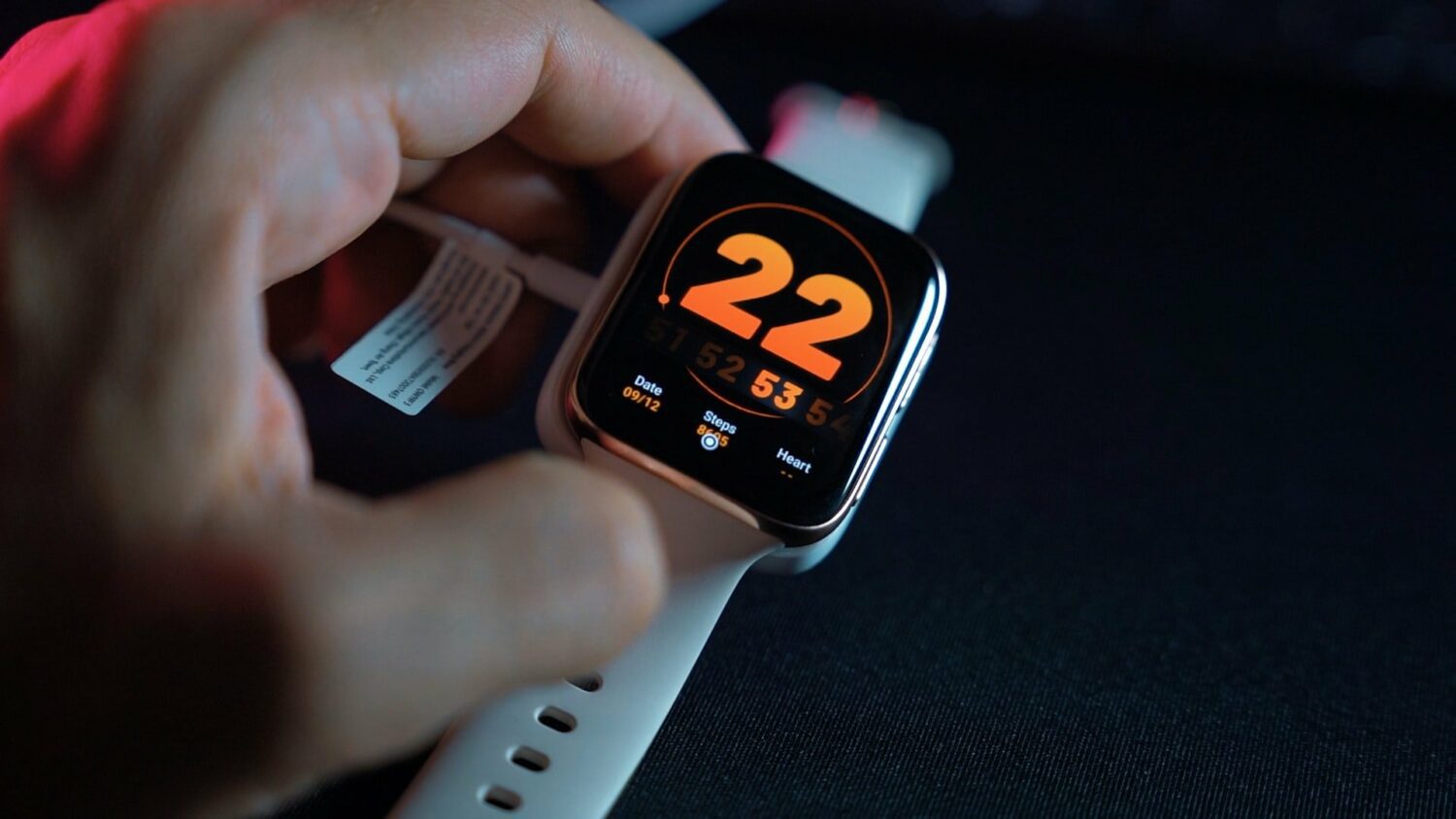
VO2max – Relative Measures, Not Absolute
So many factors influence VO2max, that it’s not the smartest idea to compare yourself. Instead of competing with your friend, who has a higher value, you should focus on improving yours. That being said, there are some standard VO2max values dependent on age, sex, and weight to see where you fit on the scale.
The reason behind this lies in aerobic efficiency. Imagine a 20-year-old 140 lbs female athlete that competes in triple jump. Why would she need the same VO2max as a 120 lbs 40 yr old male marathon runner?
The point is, your VO2max score of 47 isn’t worse than your friend’s 51. VO2max is useful when trying to improve YOUR absolute VO2max value. It is how you know you’ve progressed. The anthropometric differences in weight, muscle size, lung capacity, enzyme function, activity level all matter.
Females have a lower absolute VO2max score, by around 10. The older we are the lower our VO2max will be, provided we are at the same or lower activity level. The higher our muscle mass, the higher the absolute VO2max needs to be for a better score.
Note
VO2max is dependent on several factors like age, muscle mass, height, weight, sex, etc. It’s best to try to improve our VO2max value instead of comparing it to someone else. Different bodies have different needs.
Low Aerobic Capacity – Predictor of Mortality
Poor VO2max or low aerobic capacity increases the risk of mortality. The less oxygen we can use, the less energy we’ll create. This is bad news as it develops metabolic deficits. We have less energy, therefore we eat more and move less – not a good aging strategy.
There’s a great study examining the aerobic performance of 792 men at age 54. Factors like smoking, high cholesterol, and blood pressure increased mortality. What’s interesting is after 45 years follow-up, low predicted VO2max was the second strongest factor associated with mortality, next to smoking. (14)
Weak cardiorespiratory fitness, as shown in middle-aged men, increases the risk of mortality. Based on VO2max percentile, there were 4 groups:
- 5% <lower limit
- 45% low normal
- 45% high normal
- 5% upper limit
After a 46-year follow-up, 92% passed away – with 42.1% due to cardiovascular diseases. The 2nd level group had 2.1 years, the 3rd group 2.9 years, and the 4th group (5% upper limit) a whopping 4.9 years longer life expectancy. (15)
Fun Fact
Increasing VO2max may extend life expectancy. Statistics from one study show 1 unit of VO2max higher, so 1 ml(O2)/kg/min more was associated with living 45 days longer. (15)

VO2max – Longevity Predictor
It’s worth noting that VO2max is ONE of the key predictors of longevity. Grip strength, walking speed, intelligence (IQ), memory tests, and subjective quality of life (QoL) all matter.
Testing 122,000 people for VO2max, the results split them into 4 groups. 25-50-75-100 percentile. The higher the VO2max, the longer the lifespan, which is nice. What’s interesting is that you don’t need to be a top-level athlete to live long. The largest difference was between the 25th and 50th percentile, the higher ones having 50% reduced mortality risk – that’s a lot. (16)
Numerous studies show similar results:
- improving cardiorespiratory fitness even over 13 METs seems effective in increasing longevity. The higher the CRF level, and the lower the decline in older ages – the longer we live. (17)
- Higher cardiorespiratory fitness is associated with lower CVD risk and all-cause mortality. Those with aerobic capacity above 7.9 METs had a strong reduction in CVD or mortality risk. (18)
Fun Fact
VO2max might actually be THE STRONGEST independent marker that predicts longevity. While lifespan is genetically fixed, aerobic exercise helps a lot to reach the end of that lifespan. (19)
How to Increase VO2max?
Increasing VO2max is best done with high interval intensity training, so-called HIIT. It’s the fastest and most effective way to raise the numbers. That’s training at a pretty intense level, known as zone 5 training around 90-100% of VO2max and HRmax.
Comparing moderate intensity (MIT) vs. high interval intensity (HIIT) training: (20)
- MIIT increased VO2max by 5, without altering anaerobic capacity
- HIIT increased VO2max by 7, anaerobic capacity by 28%
- Keep in mind that HIIT was done for 7-8 sets, for 20s of maximal all-out sprint effort at 170% VO2max, with only 10s rest. Point is, it wasn’t a breeze.
But before you start sprinting you must know that the fundamental way to build endurance is low-intensity, steady-state cardio. That always comes first – as it works on the mitochondria, stretches out the heart, and causes a myriad of metabolic adaptations in favor of greater health.
That being said if you have your 10,000 steps a day dialed in, you do some light cardio like jogging, rowing, or taking a hike on the weekends, you can check the HIIT protocols as follows:
Longer Intervals
Short Intervals
training at the velocity of your VO2max. You do 1:1 ratio of activity to rest. 5 total sets of 3 minutes at VO2max velocity (that’s not sprint, but it’s pretty fast) with 3 minutes recovery – light jogging at 30% of that speed.
10 sets of repeated 30 sec. interval with 30 sec. active recovery. Speed is above 100% VO2max, meaning you cycle at 95%+ speed, as much as you can. Then to recover, cycle at half (50%) that speed for 30 sec, and repeat for 10.
Conclusion
Increasing VO2max can be tweaked fast with HIIT training. However, steady-state cardio covers the fundamentals of endurance, so don’t skip that. Short 30s. or longer 3 min. intervals at high speed with an equal recovery period at 30-50% that speed works great for increasing VO2max.
How Much Exercise is Beneficial?
To answer that question, we’ll look at two studies:
- 5-min run is as beneficial as 15-min walk, those who exercised 15 min a day had 14% lower all-cause mortality risk and lived 3 years longer. (21)
- only 5-10 min runs a day were associated to lower ACM and CVD risk. Runners, compared to non-runners have a 30% reduction in all-cause mortality and a 45% reduction in cardiovascular disease. (22)
So, for a person with a sedentary lifestyle, it’s just about finding ways to move more, not worrying if you train too much. The upper limit as we’ve seen before isn’t yet defined.
If cardio is good, isn’t more cardio better? Well, not always. There’s a U-shaped curve for cardio as well. Doing HIITs every day is taxing on the body.
What most should aim at depends on many factors. Considering you took care of the base which is 10,000 steps, active work breaks, take the stairs, cycle to work, let’s look at this. A general goal for healthy adults in terms of cardio training, I’ve learned from listening to Peter Attia’s podcasts. (I) (II) (III)
- 2-4x LISS sessions weekly. These are done at zone 2, steady state such as rowing, hiking, cycling, or jogging – lasting for 45-90 minutes (60 avg.)
- 2x HIIT or short interval, high-intensity exercise at zone 5 – this is your VO2max, aerobic power type of training you need for fast movement.
Conclusion
- VO2max is the maximal oxygen uptake your muscles can use during an intense exercise. It’s a metric used to asses your cardiorespiratory function.
- VO2max and CRF are the key predictors of longevity. Higher VO2max values mean a longer lifespan. It cuts all-cause mortality and cardiovascular risks.
- The values of VO2max are relative – dependent upon age, weight, activity, etc. They’re best used as absolutes, to track YOUR progress, not to compare with others.
- Aerobic training, especially shorter 30s. or longer 3min intervals at high speed, with equally lasting recovery are best to increase VO2max values.
- While HIIT is more effective for increasing VO2max, steady state or LISS training works on the fundamentals of endurance. It stretches out the heart, increases stroke volume, lowers resting HR and blood pressure, and provides a myriad of other heart-health benefits.

